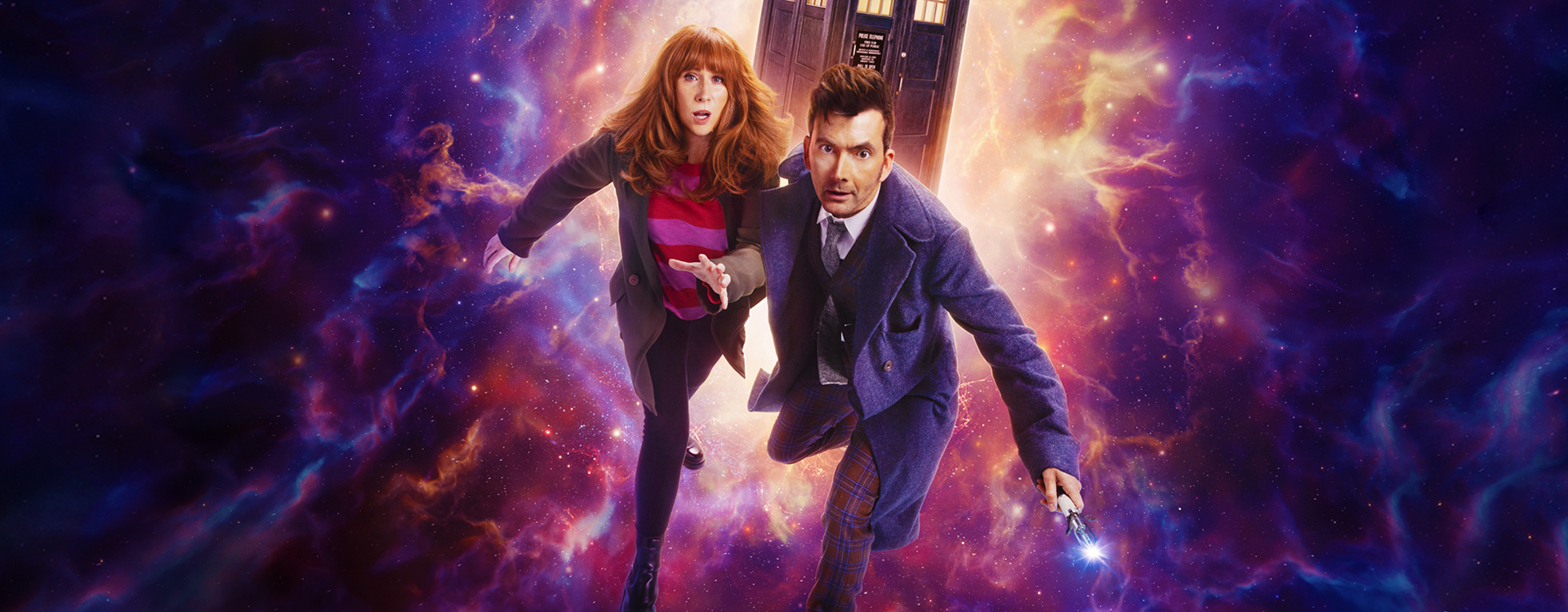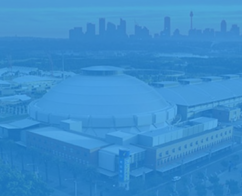
No Guest Found in this category
Doctor Who has a proud tradition of celebrating its milestone anniversaries in a big way, and 2023 is no exception. The beloved pop culture icon will celebrate its 60th anniversary on the 23rd of November and for this diamond anniversary, fans will be treated to three anniversary specials – The Star Beast; Wild Blue Yonder, and The Giggle. They’ll see the return of fan-favorite, David Tennant, as a new incarnation of the Doctor, accompanied by Catherine Tate as Donna. It’ll also see the return of a classic First Doctor enemy, the Celestial Toymaker, and see a beloved comic strip villain brought to life. It’ll be a celebratory nostalgia hit for fans, before ushering in a new era with Ncuti Gatwa’s incoming Fifteenth Doctor. So while we wait to see what other anniversary surprises lie in store for us, let’s take a look at how the show has celebrated the occasion in the past.
For the 10th anniversary in 1973, Doctor Who celebrated with its first multi-Doctor story, The Three Doctors. However, unlike subsequent anniversary specials, which typically air in November, this story opened the tenth season and actually commenced on the 30th of December, 1972, running until the 20th of January, 1973. However, it did start the trend of multi-Doctor anniversary specials, with this story seeing both William Hartnell and Patrick Troughton return as the First and Second Doctors, to share the screen with Jon Pertwee’s Third Doctor. It was nothing short of momentous, even if Hartnell’s ill health meant his Doctor only appeared in pre-recorded footage played on monitor screens, due to his Doctor getting caught in a ‘time eddy’. The story also introduced the villain, Omega, a stellar engineer who was responsible for Gallifrey’s mastery of time travel, greatly adding to the lore of the show. Finally, after three years stuck on Earth, the conclusion of the story saw the Time Lords lift the Doctor’s exile, allowing him the freedom to travel once more. It still holds up today as a great adventure and a worthy celebration of the show’s first major milestone.
The tenth anniversary proper – November, 1973 – saw the publication of a special edition of British magazine, Radio Times. This special was a treasure trove for fans and instantly became a much sought-after source of information. It included details of every story that had been broadcast up to that point, in chronological order; interviews with select cast and production members from across the show’s first decade; and an exclusive photoshoot with many of said cast members. The photos from that shoot weren’t what you might expect though, it’s clear even by today’s standards that a lot of thought and effort was put into them. Most significantly though, there was a shoot with all three Doctors in costume, which was the first time they’d all been in the same room together. On top of all that, it included an original Dalek story from their creator, Terry Nation, titled We are the Daleks. Even now, fifty years later, the magazine’s quality holds up and it’s easy to see why it’s still such a sought-after collector’s item.
By the time the show’s twentieth anniversary rolled around in 1983, Doctor Who was a bona fide institution, with the iconic Tom Baker having left just two years prior. Peter Davison’s Fifth Doctor was helming the TARDIS and the show’s executive producer, John Nathan-Turner really wanted to generate an air of celebration for the big milestone. For starters, every story that season featured a returning enemy, while fan favourite supporting character Brigadier Lethbridge-Stewart also made a return. That was just a taste of things to come though and in November the actual anniversary special, The Five Doctors, aired.
It was originally planned to be part of Season 21, but some behind-the-scenes drama led to the ninety-minute special airing as part of the British charity telethon event, Children in Need. Interestingly, the special aired in America on the actual anniversary date, the 23rd, while it aired in the UK a few days later on the 25th. It was the first time an episode of Doctor Who aired outside of the UK before its British premier. On top of that, the novelisation of the story was actually published before the special aired, meaning that fans could get a sneak peek of what was going to happen before it ever hit the airwaves. If the title didn’t give it away, it followed the precedent set by its predecessor by bringing back every previous incarnation to team up with the incumbent Doctor. Although, Richard Hurndall filled in for William Hartnell, who’d passed away in 1975, and Tom Baker was represented by archive footage after he declined to return. The special also saw the return of countless companions and villains, and marked the first onscreen appearance of Time Lord founder, Rassilon.
The twentieth anniversary also saw the biggest fan event Doctor Who had ever seen at that point. Inspired by the burgeoning fan convention scene in America, John Nathan-Turner went to the BBC’s Head of Exhibitions with a proposal for something similar in the UK. The result was Doctor Who – A Celebration, held over Easter Sunday and Monday, the 3rd and 4th of April, at Longleat House, a stately manor which at the time housed a permanent Doctor Who exhibition. Over twenty guests appeared at the event, including all four surviving Doctors and the current companions.
The convention featured everything that modern fans would expect – guest panels, photo and autograph opportunities – as well as episode screenings, visual effects displays and excitingly, sets from the upcoming anniversary special. The event was a roaring success, smashing all predictions, with approximately 40,000 people attending over the two days. In fact, it was a little too successful, with the event quickly reaching capacity, resulting in people being turned away at the gate, and a traffic nightmare for the surrounding area. Fans had been holding Doctor Who conventions for years, but never something of that scale. It wouldn’t be the only big convention of the year though, with the Americans holding their own event – Doctor Who: The Ultimate Celebration – in Chicago, from the 26th to the 27th of November, just a few days after the actual anniversary date. Over 7,000 fans attended this event, held at the Regency Hotel, which featured all four surviving Doctors as guests, as well as several companions and even some of the show’s directors.
The twentieth-anniversary celebrations didn’t stop there, however with Radio Times yet again publishing an anniversary special, which included the original comic strip, Birth of a Renegade. The National Film Theatre (now known as the British Film Institute), also held a weekend of screenings in October, in which stories from each Doctor were played, accompanied by a guest panel on the Sunday afternoon. There was also Doctor Who’s first published academic text – Doctor Who: The Unfolding Text – written by John Tulloch and Manuel Alvarado. Finally, there was the publication of a lavish coffee table book, titled Doctor Who: A Celebration – Two Decades Through Time and Space, by Peter Haining. They really went all in for the twentieth anniversary, turning the whole year into one big celebration.
For the twenty-fifth anniversary in 1988, the BBC kicked things off with a special anniversary trailer, advertising the upcoming 25th season. It saw the Seventh Doctor and his companion Ace, discussing how things had changed in the twenty-five years since the Doctor first came to Earth. The actual twenty-fifth season itself started on a strong note right out the gate, with the classic story Remembrance of the Daleks, which saw the Doctor and Ace returning to where it all began – Coal Hill School in 1963 – to fight the Daleks in a final, climatic battle. This story is beloved for a reason and it was a perfect way to start the anniversary year. The actual silver anniversary story, which began on the 23rd of November, was, appropriately, called Silver Nemesis, and saw the return of the Cybermen. Additionally, some commemorative merchandise was released, including a 25th Anniversary Album, a reference book titled Doctor Who: 25 Glorious Years, and a 25th anniversary calendar.
Sadly, Doctor Who was unceremoniously canceled in late 1989, but that didn’t stop people from celebrating its thirtieth anniversary in 1993. Originally, a special entitled The Dark Dimension was proposed, but ultimately it never went ahead. Instead we got Dimensions in Time which, just like The Five Doctors, aired as part of Children in Need. Unlike that special though, Dimensions was a bit of a mess and generally considered best forgotten by the fandom. Airing between the 26th and 27th of November, this two-part special saw the return of all surviving Doctors (which sadly no longer included Second Doctor, Patrick Troughton) and several companions.
The story saw classic villain the Rani, trapping the Seventh Doctor and Ace in London’s East End, as she attempts to collect a menagerie of every lifeform in the universe. Not only do the Doctor and Ace bounce between different years, but the Doctor constantly changes between different incarnations, while Ace changes into different companions. On top of all that, it was a crossover with the BBC soap opera, EastEnders and the whole thing was broadcast in 3D. Yeah, you have to see it to believe it. At the end of the day, it was just a shameless bit of bonkers fun to celebrate the occasion and raise money for charity.
The other significant release for the thirtieth anniversary was the documentary, 30 Years in the TARDIS, which aired on the 29th of November. As you’d expect, it provided a comprehensive look at the history of the show at that point, including a host of interviews with cast and crew members. The original broadcast version had to be cut down for time, but in 1994 an extended version, titled More than 30 Years in the TARDIS was released on VHS (and later, DVD). Other thirtieth anniversary celebrations included a Third Doctor radio drama, titled The Paradise of Death; an anniversary calendar; The Doctor Who Yearbook 1994; two reference books – Timeframe: The Illustrated History and The Doctors – 30 Years of Time Travel – and a special thirtieth-anniversary logo that adorned most videos, books and merchandise released that year.

With the new millennium came the show’s next big milestone, the fortieth anniversary in 2003. In the intervening decade, Doctor Who had made a brief return to TV with a telemovie in 1996 and although it failed to launch a new series, it did give fans an eighth incarnation of their favourite Time Lord. The Doctor had also found great success in novels and comics, as well as audio dramas that featured actors from the show reprising their roles. Most excitingly though, in September of 2003 it was announced that at long last Doctor Who would be returning with a new series. Even before that announcement though, fans had plenty of content to sink their teeth into for the anniversary year. For starters, Big Finish Productions – the primary producer of officially licensed Doctor Who audio dramas – released a host of celebratory stories, including the ‘what if?’ style Doctor Who Unbound range; the multi-doctor story, Zagreus; and a trilogy that revolved around some of the Doctor’s biggest enemies: the Master, Davros and Omega.
There was also an animated version of the incomplete Fourth Doctor story, Shada, released in May, with Paul McGann’s Eighth Doctor replacing the Fourth. This was followed by another animated story, the official BBC fortieth anniversary adventure, Scream of the Shalka, starring Richard E. Grant as the Ninth Doctor. No, not that one. This six-part story was released weekly between the 12th of November and 18th of December on the BBC’s official Doctor Who website. Interestingly, it was originally touted as an official continuation, with Grant being treated as the official Ninth Doctor for a very brief moment. Unfortunately for him though, just before the special’s debut, the announcement of the show’s live-action return was made and this underrated story was quickly rendered non-canon. Rounding out the fortieth celebrations were a documentary, The Story of Doctor Who; the reference book, The Legend: 40 Years of Time Travel, and special editions of The Radio Times and Doctor Who Magazine. DVDs released in that year were also adorned with a special fortieth-anniversary logo.
Now we come to the biggie, 2013, the fiftieth anniversary. There’s no denying that this was the peak of modern Doctor Who’s popularity and this anniversary saw the show’s biggest celebration since the twentieth. It was the first anniversary since the show’s revival and once again it felt like a year-long countdown to November. Firstly, BBC America produced a documentary series titled, The Doctors Revisited, released monthly between January and November. They also released two other documentaries, Doctor Who: The Companions on the 31st of March and Doctor Who: Explained on the 22nd of November. Not wanting to be outdone by their American counterpart, the BBC also produced their own documentary, titled, The Ultimate Guide, which was released on the 18th of November. All of these documentaries featured interviews with cast members from across the show’s history, including most Doctors and companions, as well as production members and celebrity fans.
Meanwhile, the fine folks over at Big Finish were once again celebrating on multiple fronts. The 23rd of October saw the release of their main anniversary special, The Light at the End, which featured the Fourth to Eighth Doctors. In addition to this, they also released the 1963 Trilogy, three stand-alone stories each set in the titular year. In November they released The Beginning, a story that depicted the First Doctor’s departure from Gallifrey, and which was followed by two sequel stories over the following months. Finally, they also collaborated with Audio Go, who handled the BBC’s audiobooks at the time, to produce Destiny of the Doctor. This was a series of eleven audiobooks, one for each Doctor, released monthly between January and November. They were all narrated by actors connected to that Doctor’s era, and featured an overarching plot, with the Eleventh Doctor making cameo appearances throughout the series.
As with the twentieth anniversary, 2013 also saw a massive convention, with the three-day Official 50th Celebration, held at the London ExCel centre between the 22nd and 24th of November. As expected, the event featured cast and crew from across the show’s history, including Peter Davison, Colin Baker, Sylvester McCoy, Matt Smith, Jenna Coleman and Steven Moffat. It also featured props, costumes, displays, workshops and panels – all that good stuff. Meanwhille, here in Australia, despite not having anything quite as fancy as that, we did have our own small exhibit at the ABC Centre in Sydney, complete with props and costumes from the show. We also had the ‘Doctor Who Pop-Up Shop’, which popped up at different shopping centres in Sydney, Melbourne, and Brisbane, throughout 2013 and 2014. As you’d imagine, they sold all manner of Doctor Who merchandise and collectibles. Some of the commemorative anniversary merchandise released included stamps, special editions of previously published novels, a short story collection, guide and reference books, special editions of Doctor Who Magazine and Radio Times, and limited edition coins released by the New Zealand Mint.
When it came to actual fiftieth-anniversary specials, fans were treated to two delicious appetisers before the main course. Firstly, on the 21st of November, there was the docudrama, An Adventure in Space and Time, which chronicled the early days of Doctor Who’s creation. Then there was The Five(ish) Doctors Reboot, a comedic half-an-hour special devised by Peter Davison, that saw him and his classic Doctor cohorts, Colin Baker and Sylvester McCoy, attempting to be involved in the official fiftieth anniversary special. Of course, the main event was the actual anniversary special, The Day of the Doctor, which saw David Tennant star alongside Matt Smith, with John Hurt as a newly uncovered secret past incarnation: the War Doctor. Tom Baker also appeared in a small cameo as the enigmatic Curator, strongly implied to be a future Doctor, while all other Doctors up to that point appeared via archive footage. Smith’s successor, Peter Capaldi, even made a surprise cameo.
This special was bigger than anything Doctor Who had ever produced before, with it not only being simulcast in 94 countries, including Australia, but also receiving a limited 3D theatrical run across 1,500 cinemas worldwide. The special was also preceded by two minisodes, The Night of the Doctor and The Last Day. The former is hugely significant for featuring the return of Paul McGann as the Eighth Doctor, and showing his regeneration into the War Doctor. If you weren’t there at the time, it’s hard to describe the magic of those 50th-anniversary celebrations – more than any time before or since, Doctor Who truly felt like a global phenomenon.
And that brings us to the present day, which, at the time of writing, is less than two months away from the sixtieth anniversary. It’s certainly been a quieter year compared to what we saw in 2013, but there’s still a great deal of excitement surrounding the upcoming specials. Aside from those episodes, the only other things of note that have happened for the sixtieth thus far has been Big Finish’s ongoing anniversary series, Once and Future, and the multi-platform expanded media story, Doom’s Day, which hasn’t been very well received. There was also a concert titled Doctor Who @ 60: A Musical Celebration, held in Cardiff, Wales on Thursday the 28th of September, which will be broadcast on BBC Radio 2 on the 15th of October.
Supa-Fans will be able to celebrate alongside Doctor Who’s Frazer Hines, otherwise known as Jamie McCrimmon, companion to the Second Doctor, at Supanova Comic Con & Gaming in Adelaide (4-5 November) and Brisbane (11-12 November). Appearing in 113 episodes from 1966 – 1969, Hines earned a place in the Guinness Book of Records as the longest-running companion on the BBC hit, so there will be plenty for fans to discuss.
Regardless of how big or small the celebrations ultimately prove to be, fans will still come together to honour a show that has transcended the bounds of television to become a cultural institution and a way of life for many. Like the TARDIS itself, Doctor Who is bigger on the inside and filled with the love of millions of fans spread across time and space.








